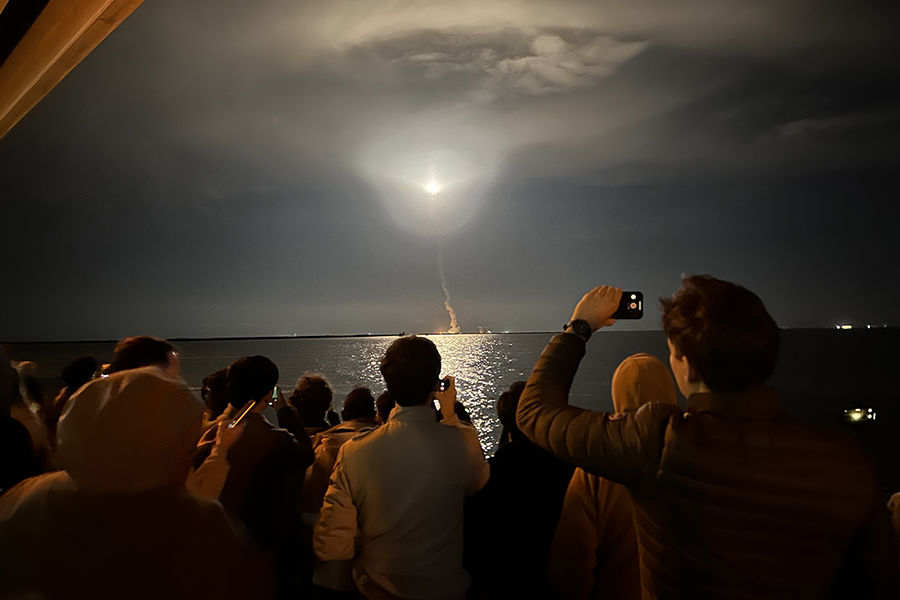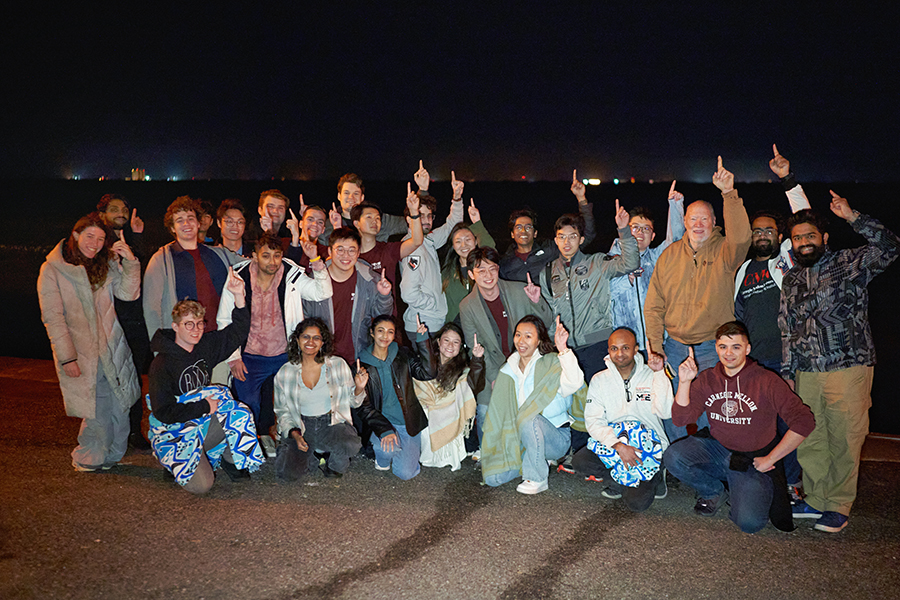
Meet Pupil, the Iris Rover’s Twin
By Giordana Verrengia
Media InquiriesIn the early hours of January 8, 2024, two CMU payloads launched off the coast of Florida, bolted to a rocket called Vulcan Centaur in support of the Peregrine lunar mission. One payload, known as the MoonArk, was a sculpture. The other was a two-kilogram rover called Iris that had been assembled by a cross-disciplinary team of 300 students—including Perrin Tong, a junior studying electrical and computer engineering.
While working on a rover bound for the moon is certainly an impressive résumé booster, it was also the chance to be a part of history, marking the first attempted soft moon landing by the United States in half a century. In another milestone, CMU was also the first university to spearhead its own lunar mission.
The Peregrine mission was executed in collaboration with Astrobotic Technology, a company founded in 2007 that specializes in “making space missions feasible and more affordable for science, exploration, and commerce.” Red Whittaker serves as the principal investigator for the rover’s development and is a company co-founder. He also holds the position of director of the Field Robotics Institute at CMU. Astrobotic’s CEO is Carnegie Mellon alumnus, John Thornton. Astrobotic has grown into a robust team of over 130 people based out of Pittsburgh’s Northside neighborhood.
Another reason the Iris project was so valuable for students was that it mimicked several aspects of the professional world. The team, composed of students from each of CMU’s seven colleges, had members pursuing degrees at every level, from bachelor’s to doctorate, in a variety of fields ranging from physics to engineering to business. There was regular personnel turnover as underclassmen joined while seniors graduated and left the project. With this dynamic in place, students were often promoted to leadership positions once they became upperclassmen, inheriting the responsibilities from teammates who had moved on from university life.
Working in a cross-disciplinary setting was the most rewarding part of the journey for Perrin. He noted that he gets plenty of electrical and computer engineering training with the traditional courses that he’s enrolled in for his major. But working alongside aspiring physicists, roboticists, artists, and businesspeople helped the team’s problem-solving capabilities because they had a more holistic approach to analyzing issues.
“Engineers have a certain mindset and physicists have a certain mindset,” Perrin said. “But this is a big project. It involves every college at CMU, so you’re meeting new people and coming across different ways of thinking. This is what makes it great—the people.”
For his part, Perrin joined the Iris team as a sophomore in January 2023, when the rover was an established, ongoing project at CMU. He was one of several students who responded to a mass recruitment effort, and it was a delight to be a part of such a prestigious opportunity as a second-year student.
While Iris was the rover that was launched into space, it was a second device named Pupil that carried out mission simulations in the run-up to the launch. The name “Pupil” matched Iris’s ocular theme and underscored the physical similarities between the two rovers. Pupil’s dimensions were the same as the original but only a sixth of Iris’s weight. Perrin was in charge of building Pupil, and saw it as a mixture of hands-on work that applied his engineering knowledge with the plentiful energy that came from working in a group.
The goal of constructing an analogous rover was to predict how well Iris would respond to a soft landing on the moon through the lens of terramechanics, which studies the interaction between wheels and soil surfaces. The place to experiment was in the Moon Yard, a giant sandbox filled with makeshift craters and rocks taken from Schenley Park to mimic regolith, the dusty layer that coats the lunar surface. Perrin’s team wanted to probe how dexterously carbon fiber wheels could navigate such an environment since it was the first time the material had been used on a rover meant for lunar exploration.
Perrin spoke to the value of conducting mission simulations.
“We've made some terrible mistakes, but that also exposed us to more opportunities. We know what we're doing wrong, and I'm glad we know what we're doing wrong because we're in a simulation. We can afford to do things wrong. That has dramatically improved the way we approach a problem. I think mistakes are great.”
Current and previous members of the Iris team traveled to Florida’s Space Coast to watch the launch at the start of the new year. Hours before the Vulcan Centaur rocket was due to take off, a cross-section of faculty, alumni, and students reunited at dinner, where they had the chance to reminisce about preparing the rover for its mission—which also happened to be the first attempted lunar exploration by the United States since the late 1960s. Perrin describes the lead up to the launch as a surreal experience. It wasn’t until Nikolai Stefanov, the mission lead, and Connor Colombo, the chief engineer, began delivering their speeches at the pre-launch party that Perrin felt the moment was becoming a reality.
Perrin remembers seeing a rainbow outside the airport when he landed in Orlando, as well as a dolphin that swam in front of the group’s viewing spot for the launch. He took those as good omens for the mission. At 2:18 a.m., the moment the rocket launched and the sky lit up, Perrin felt a cocktail of emotions—pride at witnessing the culmination of the team’s efforts, and, like a true engineer, some nerves about the execution. As he stood stunned and speechless, the Vulcan Centaur shrinking to a speck in the sky, a flood of congratulatory messages poured in from friends and professors.
Despite the hiccups in the mission which ultimately resulted in the rover returning to earth, Perrin’s strongest takeaway is a piece of advice from Colombo, the project’s chief engineer: cherish the people on this team, because a corporate setting won’t be the same.
“We’re making mistakes and we’re learning a lot,” said Perrin. “But in the end, what we’re getting out of this experience is the relationships we’re building with all these people.”
